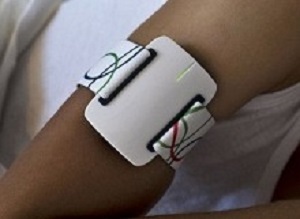 A new high-tech bracelet, developed by scientists from the Netherlands, detects 85% of all severe night-time epilepsy seizures. That is a much better score than any other technology currently available. The researchers involved think that this bracelet, called Nightwatch, can reduce the worldwide number of unexpected night-time fatalities in epilepsy patients.
A new high-tech bracelet, developed by scientists from the Netherlands, detects 85% of all severe night-time epilepsy seizures. That is a much better score than any other technology currently available. The researchers involved think that this bracelet, called Nightwatch, can reduce the worldwide number of unexpected night-time fatalities in epilepsy patients.
SUDEP, sudden unexpected death in epilepsy, is a major cause of mortality in epilepsy patients. People with an intellectual disability and severe therapy resistant epilepsy, may even have a 20% lifetime risk of dying from epilepsy. Although there are several techniques for monitoring patients at night, many attacks are still being missed.
Consortium researchers have therefore developed a bracelet that recognises two essential characteristics of severe attacks: an abnormally fast heartbeat, and rhythmic jolting movements. In such cases, the bracelet will send a wireless alert to carers or nurses.
The research team prospectively tested the bracelet, known as Nightwatch, in 28 intellectually handicapped epilepsy patients over an average of 65 nights per patient. The bracelet was restricted to sounding an alarm in the event of a severe seizure. The patients were also filmed to check if there were any false alarms or attacks that the Nightwatch might have missed. This comparison shows that the bracelet detected 85% of all serious attacks and 96% of the most severe ones (tonic-clonic seizures), which is a particularly high score.
For the sake of comparison, the current detection standard, a bed sensor that reacts to vibrations due to rhythmic jerks, was tested at the same time. This signalled only 21% of serious attacks. On average, the bed sensor therefore remained unduly silent once every 4 nights per patient. The Nightwatch, on the other hand, only missed a serious attack per patient once every 25 nights on average. Furthermore, the patients did not experience much discomfort from the bracelet and the care staff were also positive about the use of the bracelet.
These results show that the bracelet works well, says neurologist and research leader Dr Johan Arends. The Nightwatch can now be widely used among adults, both in institutions and at home.
Arends expects that this may reduce the number of cases of SUDEP by two-thirds, although this also depends on how quickly and adequately care providers or informal carers respond to the alerts. If applied globally, it can save thousands of lives.
Abstract
Objective: To develop and prospectively evaluate a method of epileptic seizure detection combining heart rate and movement.
Methods: In this multicenter, in-home, prospective, video-controlled cohort study, nocturnal seizures were detected by heart rate (photoplethysmography) or movement (3-D accelerometry) in persons with epilepsy and intellectual disability. Participants with >1 monthly major seizure wore a bracelet (Nightwatch) on the upper arm at night for 2 to 3 months. Major seizures were tonic-clonic, generalized tonic >30 seconds, hyperkinetic, or others, including clusters (>30 minutes) of short myoclonic/tonic seizures. The video of all events (alarms, nurse diaries) and 10% completely screened nights were reviewed to classify major (needing an alarm), minor (needing no alarm), or no seizure. Reliability was tested by interobserver agreement. We determined device performance, compared it to a bed sensor (Emfit), and evaluated the caregivers’ user experience.
Results: Twenty-eight of 34 admitted participants (1,826 nights, 809 major seizures) completed the study. Interobserver agreement (major/no major seizures) was 0.77 (95% confidence interval [CI] 0.65–0.89). Median sensitivity per participant amounted to 86% (95% CI 77%–93%); the false-negative alarm rate was 0.03 per night (95% CI 0.01–0.05); and the positive predictive value was 49% (95% CI 33%–64%). The multimodal sensor showed a better sensitivity than the bed sensor (n = 14, median difference 58%, 95% CI 39%–80%, p < 0.001). The caregivers' questionnaire (n = 33) indicated good sensor acceptance and usability according to 28 and 27 participants, respectively.
Conclusion: Combining heart rate and movement resulted in reliable detection of a broad range of nocturnal seizures.
Authors
Johan Arends, Roland D Thijs, Thea Gutter, Constantin Ungureanu, Pierre Cluitmans, Johannes Van Dijk, Judith van Andel, Francis Tan, Al de Weerd, Ben Vledder, Wytske Hofstra, Richard Lazeron, Ghislaine van Thiel, Kit CB Roes, Frans Leijten
[link url="https://www.tue.nl/en/news/news-overview/24-10-2018-new-epilepsy-warning-device-could-save-thousands-of-lives/"]Eindhoven Institute of Technology material[/link]
[link url="http://n.neurology.org/content/early/2018/10/24/WNL.0000000000006545"]Neurology abstract[/link]
